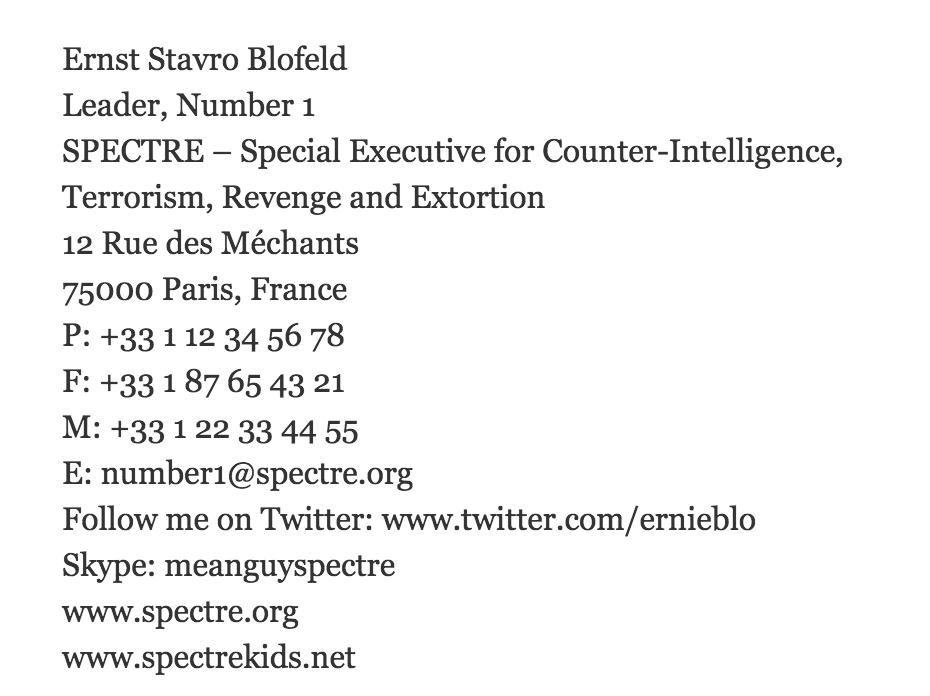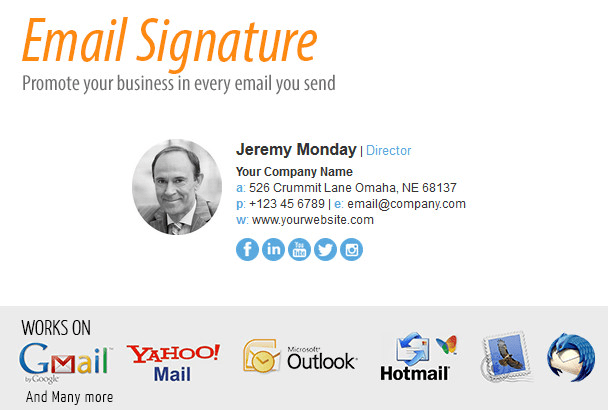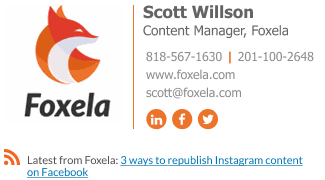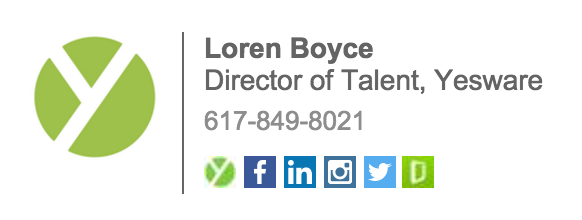Leaving a lasting impression is hard. Doing it at the end of an email is even harder.
That’s probably why so many of us end up searching for
professional email
signature examples every time we change jobs, get a promotion, or have a
sneaking suspicion that our current sign-off isn’t up to par.
A strong email signature is attention-getting, but professional. It’s not flashy, but it’s not bland either.
With that in mind, we’ve rounded
up some of the best email signature examples, so you can see exactly
what you should and shouldn’t include in yours. We’ll also share 3 tools
you can use to create your own unique email signature in a snap.
Tight on time? Jump around to any section.
[hide]
1. Limit your signature to three or four lines of text
Don’t overthink it. All you really need is:
Your Name
Title (optional), Company (linked to website)
Phone number
Simple, right? Here’s an example of what that might look like:
Once you have the basic format, consider adding one or two of the following options to personalize your sign-off.
How to make it personal: 3 email signature examples
1. Social media profiles that show off your professional brand.
Sales reps may want to include their
LinkedIn profiles, while job seekers might argue they’re more active on Twitter.
Check out this email signature
example from Yesware’s Director of Talent, Loren Boyce. She uses many
different social media channels in her day-to-day role to connect with
potential sales candidates, so it naturally makes sense to include them
all as points of contact.
2. Stellar content that showcases your expertise
Have a product you want to tell
the world about? A blog post that expertly outlines what you have to
offer? Share it in your signature like Aaron Ross does in his:
3. A Call-to-Action
This
is a line of text that prompts your recipient to take action. The action
you want them to take could be just about anything: schedule a demo,
attend an event, download an ebook, etc.
For example, here’s how Yesware’s very own Elise Musumano encourages people to visit our blog in the last line of her signature.
Caveat: Listing every possible phone number, email address, or social media network you belong to is overkill. In fact, — a phenomenon known as the Paradox of Choice.
Here’s an example of an overstuffed email signature from The New York Times (fictionalized).

That’s 15 lines of text. Imagine how painful it would be to read on a mobile device.
2. Don’t put your email address in your email signature
I love this analogy Slate uses to describe the baffling yet common practice of including your email in your email signature.
It’s like placing two return
address stickers on an envelope. Or, at a party, reintroducing yourself
after the host has already done so.
“Mary, this is Kevin.”
“Hi, Mary. My name is Kevin.”
It’s an unnecessary waste of space because:
- In nearly every email client, hovering the mouse over the sender’s name will display the address, unless it’s already visible.
- You can always just hit reply.
Save the real estate for
something that actually adds value — i.e. links to social media
profiles, your company’s blog, your portfolio, etc.
3. Include an image (and don’t shy away from color)
People remember visuals better than text. But there’s a certain kind of image that can make your email signature especially memorable.
See that beautiful mountainside below?
You’re probably going to forget it.
You’re more likely to remember this.
Bottom line: Consider putting a face to your name if you want to stand out from the crowd.
4. Try “Sent from my iPhone”
A team of Stanford researchers recently studied the perceived credibility of misspelled emails sent with (and without) a “
Sent from my iPhone” signature. One big takeaway:.
What the researchers found was
that when emails use correct grammar, spelling, and punctuation, the
sender is perceived to be very credible — regardless of whether they’re
writing from their phone or computer.
However, study participants
attributed higher credibility to the person who wrote a sloppy email
signed “Sent from my iPhone.” They were more forgiving of errors, as the
chart below shows:
So does this 19-character
disclaimer really offer a free pass out of writing detailed replies? Our
advice is to know your audience. For every person willing to look the
other way, there’s another who sees it as an annoying form of
humble brag.
Bottom line: Don’t be afraid to use a mobile email signature if you’re
on the go
and it makes your life easier. If you’re not feeling the standard “Sent
from my iPhone” or use a different mobile device, you can always create
your own sign-off that follows the same general logic:
Apology/Location/Status [Communication] from [My] [Device].
-
- Sent from a phone. Regularly foiled by autocorrect. But duck it.
- *Brevity and errors aided and abetted by my beloved iPhone*
- From my smartphone so please forgive any dumb mistakes.
- iPhone. iTypos. iApologize.
- [Name] sent the message. iPhone sent the typos.
- Please excuse any tpyos as it was sent from my iPhone.
- Sent from my iPhone. Forgive the brevity, the typos and the lack of nuance.
- Sent from mobile device, all error self inflicted.
5. Try one of these 3 free email signature generators
The good news is that you don’t
have to take all this advice and whip up a brand new email signature
yourself. There’s an app for that.
Here’s three we think you’ll want to take a look at.
1. WiseStamp
WiseStamp
is a free email signature generator that integrates with your email
client and automatically loads beautifully designed, customized email
signatures into your compose window.
WiseStamp makes it easy to add
in a photo, a live RSS feed that pulls your latest blog or social
content, and more to your signature. Here’s a sample email signature of
theirs that we particularly like:
2. newoldstamp
If you’re looking for something a little bit more unique, check out
newoldstamp.
You can choose between 11 professional email signature templates in a
variety of colors and formats, and incorporate a photo and social
buttons.
We really liked their Autumn Feeling design:
Another great option is the Full Moon layout:
3. htmlsig
For a neat, basic email signature with just enough information and no unnecessary frills, try out htmlsig.com.
And here’s how to manually set up your email signature (if you so choose):
- How to set up your email signature in Gmail
- How to set up your email signature in Outlook 2013 and 2016
- Email signature set up instructions for Outlook 2010
















 That’s 15 lines of text. Imagine how painful it would be to read on a mobile device.
That’s 15 lines of text. Imagine how painful it would be to read on a mobile device.









